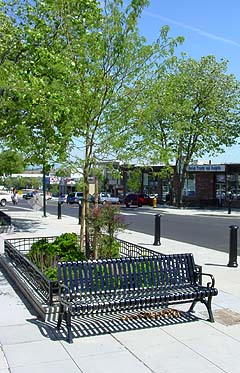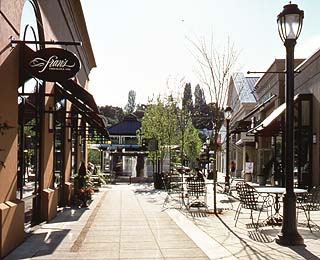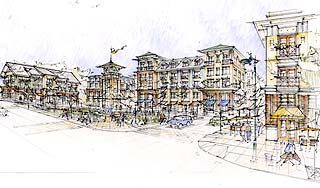
Surveys
DJC.COM
December 11, 2003
Town centers rediscovered after years of neglect
GGLO

Photo by Mark Wainwright
The recently completed 152nd Avenue streetscape improvements are the first steps in creating a stronger, more identifiable Town Square in Burien. |
Mention “urban renewal” to most real estate professionals and you're likely to get looks of indifference, a few chuckles and possibly an outright dismissal.
Investing real estate money, time and effort in smaller, more complicated infill developments under the tight scrutiny of local neighbors and officials seems contrary to reason. Suburban areas offer seemingly endless room for expansion with sites that are easy to develop and lease.
The realities, however, are that suburban development is under the gun due to its impacts on increased traffic congestion, decentralization and dispersion of limited public resources and open space preservation.
Conversely, urban redevelopment is on the increase, addressing years of neglect heaped upon our dying town centers, gaining momentum through political campaigns and the progressive urban design community, and transforming the once suburban “edge” cities into centers with a clear identity.
This political and economic shift is creating opportunities within urban settings for real estate investment, development and sales that less than a decade ago seemed impractical. Let's investigate these opportunities by introducing a few of the organizations and mandates guiding these changes, and then discuss a few central concepts of urban redevelopment and how these concepts will affect the commercial real estate profession.
A sense of community

Photo by Eckert & Eckert
Successful local and national retailers in a quality development, like University Village, will appeal to real estate investors, developers and brokers. |
Numerous organizations and resources are dedicated to the concept and success of town center redevelopment. The Urban Land Institute, founded in 1936, offers numerous publications, forums, and educational opportunities on the subject of responsible land use and development.
Recognizing the potential of boundless suburban sprawl and the stretching of limited resources, the state's Growth Management Act exists to promote “smart growth” and provide guidelines for urban infill development, reduction of sprawl and economic development. The concept of urban redevelopment that creates or reinforces the center of a town or neighborhood is a foundation stone in the Charter of the New Urbanism, a guiding mission statement from the Congress of the New Urbanism, or CNU.
CNU was created in the early 1990s, but its roots reach back to the pre-war town squares, before the mass exodus to the suburbs of the 1950s and 60s. CNU stands “for the restoration of existing urban centers (and) the reconfiguration of sprawling suburbs into communities of real neighborhoods.”
Visions of Independence Day parades and of barbers sweeping their sidewalks appear in our minds as we discuss these universally agreeable themes. A stronger sense of community and a better identification with our neighborhoods are ideas that appeal to us all. The real question on most minds, however, has yet to be posed.
So how will this movement and these mandates affect the real estate market?
The ideas presented here serve less to answer all of the questions and more to bring a greater understanding of town center “rediscovery” and to recognize the relationship between the increase in infill development, the resulting design trends, and the professionals in the real estate market who will be affected by these dynamics.
So what does this mean, specifically, to real estate professionals? Will this change the face of the industry completely?
Taken in relative terms to the overall size and scope of the real estate industry, the changes introduced will be neither large in size or radical in nature, but are definitely a trend of which all industry professionals should be aware.
In an effort to draw some direct connections between these emerging trends and the real estate industry, we'll focus on a few central concepts: a geographic shift from suburbs to urban centers; the inclusion of a mix of uses in buildings and developments instead of a single use; a greater emphasis on the pedestrian; and the creation of unique places.
Refocusing to urban centers

Rendering by Anita Lehmann, AIA
New town centers will combine housing, retail and office uses, such as the proposed Madison Park Village in Tacoma. |
It all seemed so simple. “Build it and they will come,” to use an all-too-versatile quote. And that's what post-war developers and planners did. Huge residential developments within walking distance of virtually nothing but within a 20-minute drive of everything were created, dependent on the automobile and subsidized by miles of highways.
Population growth has changed that “easy access” to 50 and 60 minutes, and now we have empty town centers that once teemed with activity. The shift back to these areas is the new challenge, one that affects developers, designers and real estate professionals.
The seemingly endless space in the suburbs for retailers and corporations may engender an appealing location, but the opportunities in passed-over towns are surprising. The Burien Town Square project, as conceived, covers over 9 acres in the middle of town. Northgate offers over 15 acres of land for future redevelopment. These urban developments will provide retail and office investors, as well as tenants, with options that contrast super-mall and industrial park spaces with unique locations geographically closer to higher population density.
Redeveloping urban centers will involve many different types of clients. Existing retailers who define what a small town is will need to coexist with new stores. It is the job of both developer and broker to situate all tenants in a way that benefits everyone and appeals to a broad customer base. The town centers that do this the best will flourish. The others will neither support the existing retail “culture” nor draw new and different storefronts into the mix.
Incorporating a mix of uses
And a mix is exactly what is needed. New town centers will need to be active for as many hours during the day as possible. Single-use buildings, like those found in most office parks, do not add to extended activity and will weigh upon the success of the project. Think of the mix of uses as a connected string of daily events. Where do people live? Where do the residents get their newspaper and morning cup of coffee? Where do they drop off their dry cleaning? Where do they work? How about lunch? Shopping after work for a child's gift? What about dinner that night?
The answer to all of these questions would hopefully be no further away from each other than a 10-minute walk. Although not easy, these scenarios are possible.
“From an investment perspective,” says Paul Sleeth, a senior vice president with Colliers International in Seattle, “there are difficulties with mixed-use developments due to the various types of real estate stakeholders coming together in one project, but the opportunities still outweigh the negatives.”
Challenges exist for developers and brokers as well, but a financially interdependent mix of retail, office, housing and other uses can prove a solid investment through periods of change in the real estate market.
Balancing the transportation equation with the pedestrian
How can a pedestrian-centric type of development benefit the real estate professional? If the designers and developers have done their job, the active sidewalks and public spaces will attract and retain customers. Parking will still be necessary, but will be secondary to pedestrian traffic, either placed behind or underneath the commercial spaces.
The concept of shared parking for a mixture of uses reduces the total demand represented by the separate and individual uses. Plus, a more pleasant place to shop will emerge, inviting customers to stay longer, be happier and patronize the businesses more. And profitable, active retailers create desirable commercial spaces.
Making it unique
Towns and neighborhoods have always had a unique and identifiable character that may have been lost or diluted over years of change. Now, with an opportunity to rediscover that identity, new town center and neighborhood developments are ready to provide “places” that are memorable.
This “placemaking” movement is evidenced in older neighborhoods — like Fremont in Seattle and the Pearl District in Portland and in developments like RiverPlace in Portland and Santana Row in San Jose — where a mix of housing, retail and commercial uses in a unique setting provide a memorable experience for residents and visitors.
The process of rediscovery in our forgotten town centers and urban neighborhoods presents a host of questions, only some of which are answered here. The goal, rather than answering all questions, is to elevate the discussion between all parties involved in the design, development, investment in, and sale of properties that are driven by the move to revitalize our town centers.
Large, single-use office and industrial parks will continue to exist. Suburban populations will increase. “Retailers, and investment dollars, will continue to follow growth in suburban areas,” Paul Sleeth states, “but quality infill developments that provide greater density and more active neighborhoods offer good opportunities for commercial developers.”
Although still engendering an occasional look of doubt, commercial real estate professionals are beginning to take a new look at the opportunities that exist in urban revitalization. We all must recognize the importance of breathing new life into the heart of our communities.
It must be our goal, as the designers of our communities, the developers of our new and aging urban cores, and the brokers for the future financial lifeblood in our towns, to seek out and take advantage of the opportunities that will avail themselves in this new era.
Alan Grainger, AIA, is a principal at GGLO.
Other Stories:
- Insights Program looks at commercial real estate
- Grocery stores cooking up more innovations
- Retail chic: Shopping centers with meeting places
- Development is changing; training should be, too
- When the government takes your property
- Don't get fenced in: Use a land title survey
- Are you paying too much property tax?
- A new corridor may be coming down the Pike
- Columbia City — the next hot spot?
- Yakima Valley real estate heats up
- Northwest taps into waterfront properties
- Interest rate hike could mean time to sell
- David A. Sabey
- James N. Carbone
- John Solberg
- Mic Dinsmore
- Mark A. Weed
- Portland's economic Rx: a biotech future
- The recovery train has left the station: Are we on it?
- Are hotels overbuilt or just overproposed?
- Tax credit program boosts low-income communities
- Debt can be good for nonprofits' projects
Copyright ©2009 Seattle Daily Journal and DJC.COM.
Comments? Questions? Contact us.